Water is one of the main components of the human life. The health of the body depends on its purity and mineral composition. Water obtained from a well on an individual area or taken in a well in the country must comply with sanitary standards to benefit, and not harm.
As for the water obtained from the deep well, and for the contents of the Dacha Well there are two main problems. They are associated either with excess mineralization, or caused by a high content of iron. Water contaminated with iron is most of concern to the greatest extent, as it has not only an unpleasant taste, but also a rusty shade.
Sources of drinking water
Many destructive salts and other elements are located in fresh water sources with different mechanical nature, with their unique mineral composition. We get water from the following sources:- water pipes saturated by rivers and lakes;
- Security mines with spring water;
- Artesian wells raising water from deep subsoil.
The liquid is not always safe, therefore requires mechanical and chemical cleaning.
How to recognize the presence of iron in water
One of the main methods for determining the presence of iron in water from the well is its upset. After some time, imperceptible at first, the iron dissolved in water begins to interact with air oxygen as a result, the process of its oxidation occurs and the cutter can be sediment at the bottom of the tank.
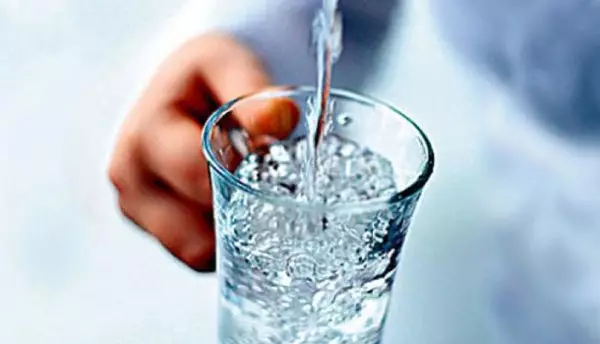
In some cases, it can be felt that the water typed from the well has a smell of iron. This is another sign of iron content in water.
Negative Iron Consequences
If the rusty water obtained from the well is detected, active actions should be made to purify it from iron. It is determined by the fact that iron impurities can harm not only health, but also lead to a damage of the plumbing system, the pump, the wear of the plumbing.- Negative consequences of the effects of elevated iron concentrations on health are expressed in the appearance of body allergic reactions on the skin, stomach and intestinal disorders.
- Rusty raid, precipitating on the walls of the pipeline system in the presence of comfortable conditions, begins to grow with time due to the reproduction of bacteria, which inevitably leads to a breakdown of water supply equipment.
Article on the topic: Panel from natural material on the topic of autumn with photos
To avoid these negative consequences, it is enough to know how to clean the water from iron. We offer to familiarize yourself with the main methods of disbursement of water from a well or well that can be used at home.
Water settling
This method is most accessible and easy to implement. It is the inclusion in the water supply system of the country house or the cottage of an additional reservoir, the container of which is selected according to the daily need in water. The advantages of this method are to be in its cheapness and possibilities of use with electricity disconnected. Against the use of a setup method acts such facts as:
Ozonization
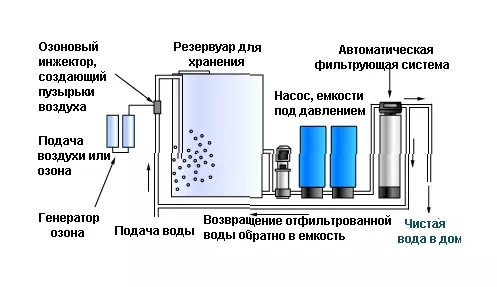
Get rid of iron in water from the well with their own hands by applying ozonation is quite difficult. This is due to the fact that for these purposes it is necessary to acquire and labor-intensive installation of additional equipment, the cost of which is very high. Therefore, it is worth thoroughly calculate how effective the use of ozonization will be.
The calculation technique is based not only in the performance of the daily need in water, but also directly depends on the type and the amount of harmful impurities dissolved in it.
Aeration
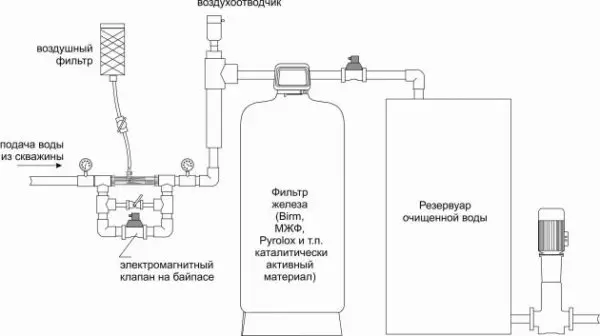
This method allows you to remove iron from water by affecting it oxygen contained in the air. Water aeration can be carried out in two ways:
- Non-variable way. It is to use special sprayers, passing through which the liquid fills the tank. To increase the efficiency of this method, water tank is equipped with a compressor, to provide additional air supply.
- Pressure method. Aeration occurs due to water supply under pressure in a special aeration column. Inside the column, violent foaming of water occurs, which is created due to the strong head of the jet and the discharge of air flows produced by the compressor. This process contributes to the rapid enrichment of water with oxygen.
The undoubted plus of aeration purification is its absolute environmental friendliness. From disadvantages it should be noted the need to install at the output from the tank of special mechanical filters that need regular cleaning. According to the degree of purification, this method is superior to settling, but the total getting rid of the water from iron does not guarantee.
Water filtering from iron
Cleaning water from the well from iron with your own hands by installing filters at home. Consider in more detail what cleaning methods are used in filtering technologies.Ionic exchange method
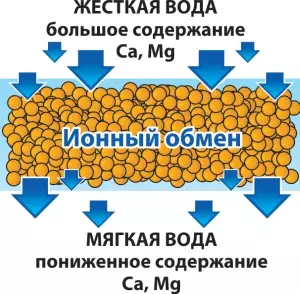
The cleaning method is as follows: when water passes through the filter, the material of the manufacture of which serves a fine-barred resin of synthetic origin, the ionic substitution reaction occurs. The fact is that the resin contains free ions - cation, which, by means of this reaction, are replaced by iron ions. At the outlet of the filter, water completely purified from iron is formed.
Catalytic water purification method
These filters implemented the ability of various chemicals to act as catalysts generating oxygen when interacting with water. Passing through the filter, the iron dissolved in water decays to the smallest particles, which are subsequently eliminated and falling into a precipitate. The disadvantages of this method should include the need for preliminary water purification by aeration or introduction of reagents, in order to protect the filter from the effects of large impurities.Article on the topic: Combus for a newborn crochet or spokes according to the schemes
The method of reverse osmosis
This method ensures the most complete water purification compared to others. This is achieved due to the fact that the filter membrane is able to delay any types of contaminants at the molecular level. Basically, molecular reverse osmotic membranes are designed to purify water not so much from iron, but from bacteria and salts.
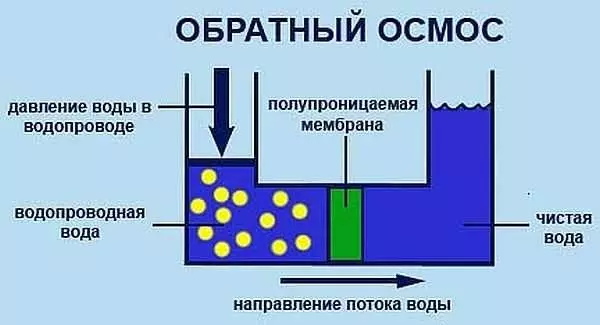
Since the cleaning technology in them is very thin, it is necessary to provide pre-purification of water from large impurities using mechanical filters. It is also worth noting that the cost of membrane filters is high enough.
Water purification system from well
In cases where the water supply of the house is carried out at the expense of water taken in the well, it is recommended to use a multistage filtering system. The main steps of this system are:Why do you need cleaning water from lime?
Considerable difficulties creates lime (calcium and magnesium bicarbonates), present in excess quantities in the waters of many regions, and negatively affecting such aspects:
- on health: the metabolism is disturbed, the condition of the skin, hair, teeth deteriorates;
- On the functions of the internal organs: the formation of insoluble calcinates affecting the operation of the urogenital, bile and cardiovascular system, muscle and nerve tissues and increasing blood coagulation;
- On cooking (the duration of the process increases, and product qualities are changed).
Poor quality of limestone water creates such problems:
- Household difficulties: soap does not foam, raid on the walls of the dishes are formed, there are white divorces on clothes after washing;
- Influences mechanisms: When heated, calcium carbonate forms a dense insoluble precipitate on systems of boiler and boiler equipment, household appliances, plumbing parts, leading to a breakdown and increase power supply;
- negatively affects engines and carburetors of machines and other techniques where water is used;
- Hard lime water is detrimental for plants, preventing the absorption of useful trace elements.
When using lime water, the risk of developing skin diseases in babies is 87%.
How to clean water from lime
The choice of a mitigation method depends on the place of the fence of fluid and the target use. Clearing water from the well, apply:Chlorine for boiling forms a dangerous compound - chloroform, which, with long-term exposure to the body, contributes to the activation of cancer cells.
Article on the topic: Tunic for the girl with spokes with a circular coquette: Schemes with description
If there is a water supply, effectively use:
Water from the well has many impurities taken from groundwater, but clean it easier than from the well.
How to clean the water from the well from the lime
The water of deep occurrence, served from the well, have greater rigidity. More complex methods are used to mitigate.
Reverse osmosis
This is a deep cleaning system that occurs on ion damage. The method of purification is based on the difference in pressures created on both sides of the semi-permeable membrane. The principle of operation lies in the flow of water into the first module having a polypropylene filter cleansing from insoluble particles.Then follows the transition to the second, coal, eliminating organic and chemical impurities. Further, the fluid passes into the original rolled module (through a homogeneous membrane, the size of the holes of which is equal to the water molecule, and calcium salts are deposited on the filter surface). Water is divided into two streams: net goes into the plumbing, and with impurities in the sewer.
The system works when using an additional pump that increases water pressure, and connects to the power grid. Thanks to the built-in mineralizers, the required amount of missing salts is added. The method of reverse osmosis is considered one of the most suitable when cleaning the liquid from the well.
Coagulation
Refers to a chemical and mechanical process and works when using additional containers and pumps. The essence of the method is to restore (due to the chemical reaction of the coagulant with calcium and magnesium molecules) dissolved in water carbonates into a solid state. Removal of sediment by mechanical method, and filtering - any available option.
The advantage of the method is a high degree of cleaning (up to 1 microme). The correct choice of coagulant depends on the pH level and the chemical composition of the purified fluid. Inorganic reagents are used to soften water. These include trivalent iron and aluminum salts. They contribute:
- changing the pH level;
- electrical conductivity;
- Outdiction.
Modern systems can automatically adjust the number of coagulant. With seasonal changes in the composition of water (for analyzes) requires the correction of the scheme. The coagulation process is used as an independent method, as well as one of the branches of the system of the system.
Water from the well is clean only from biological impurities, and mineral composition can be dangerous!
Ultrafiltration
The method is similar to the reverse osmosis, only the membrane is used fiber-porous. The flow fluid passes through the filter, cleansing from colloidal lime, harmful organic particles and pathogenic microflora.Chemical filtration
Is one of the cheapest ways. In this case, the reagent appears to the lime. As a result of the chemical reaction, calcium carbonate is deposited. The liquid is defended and filtered. Both the advantage of the method and danger is the availability of the reagent.
